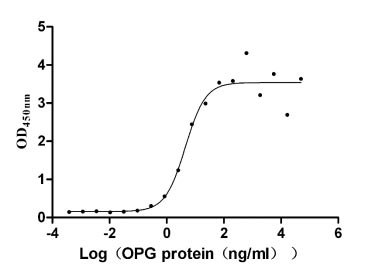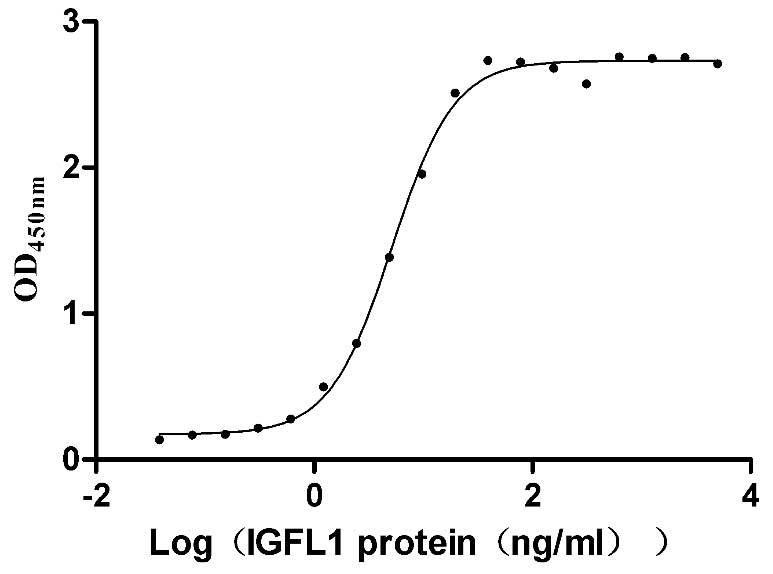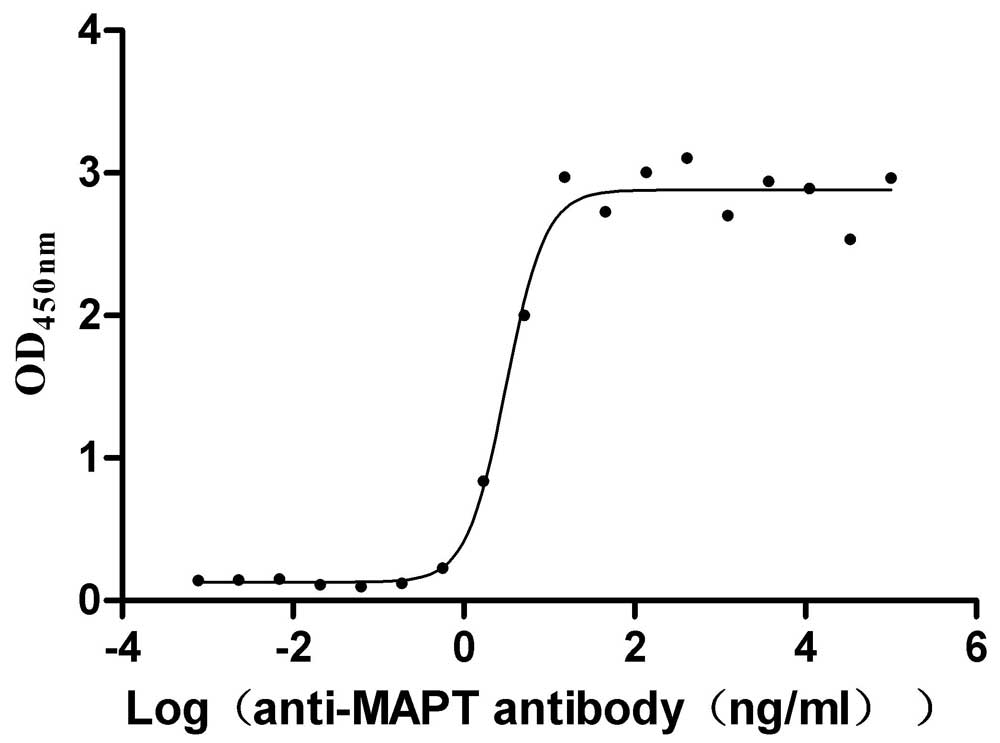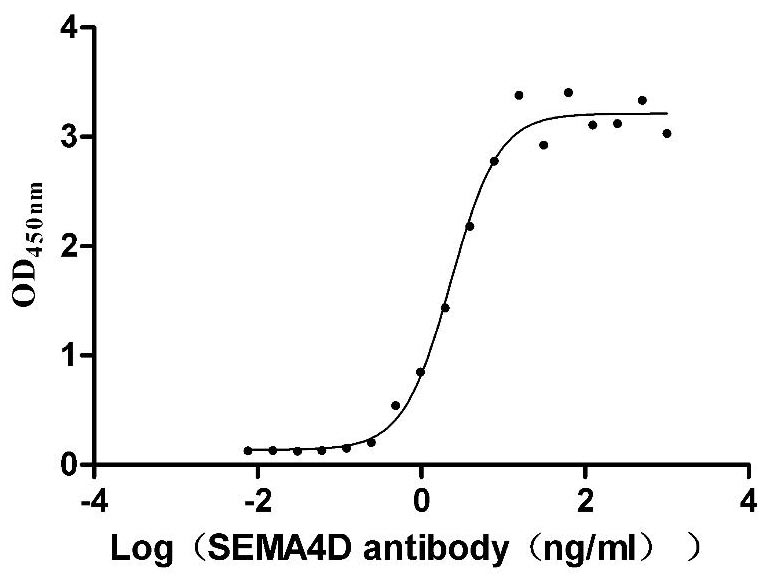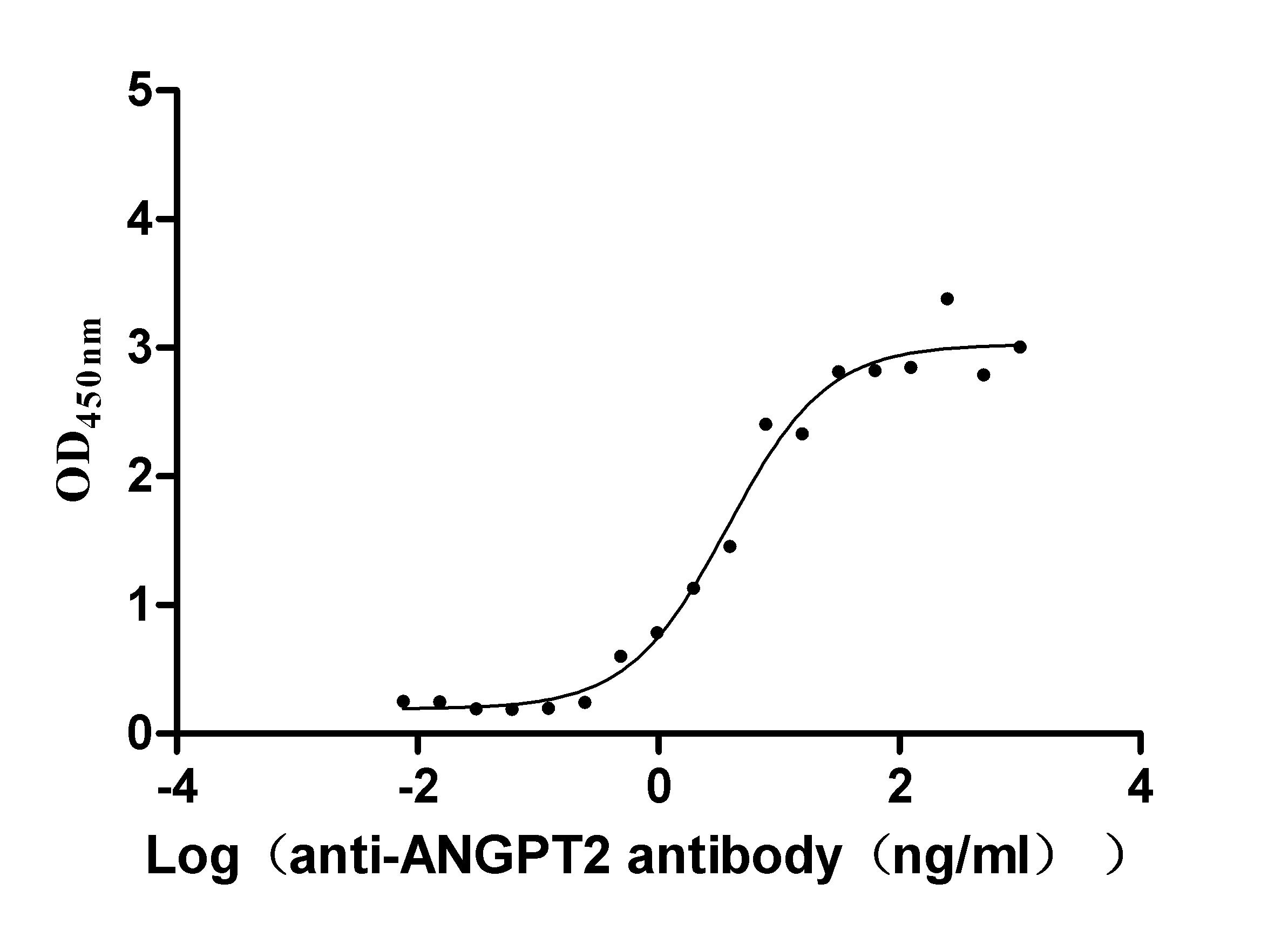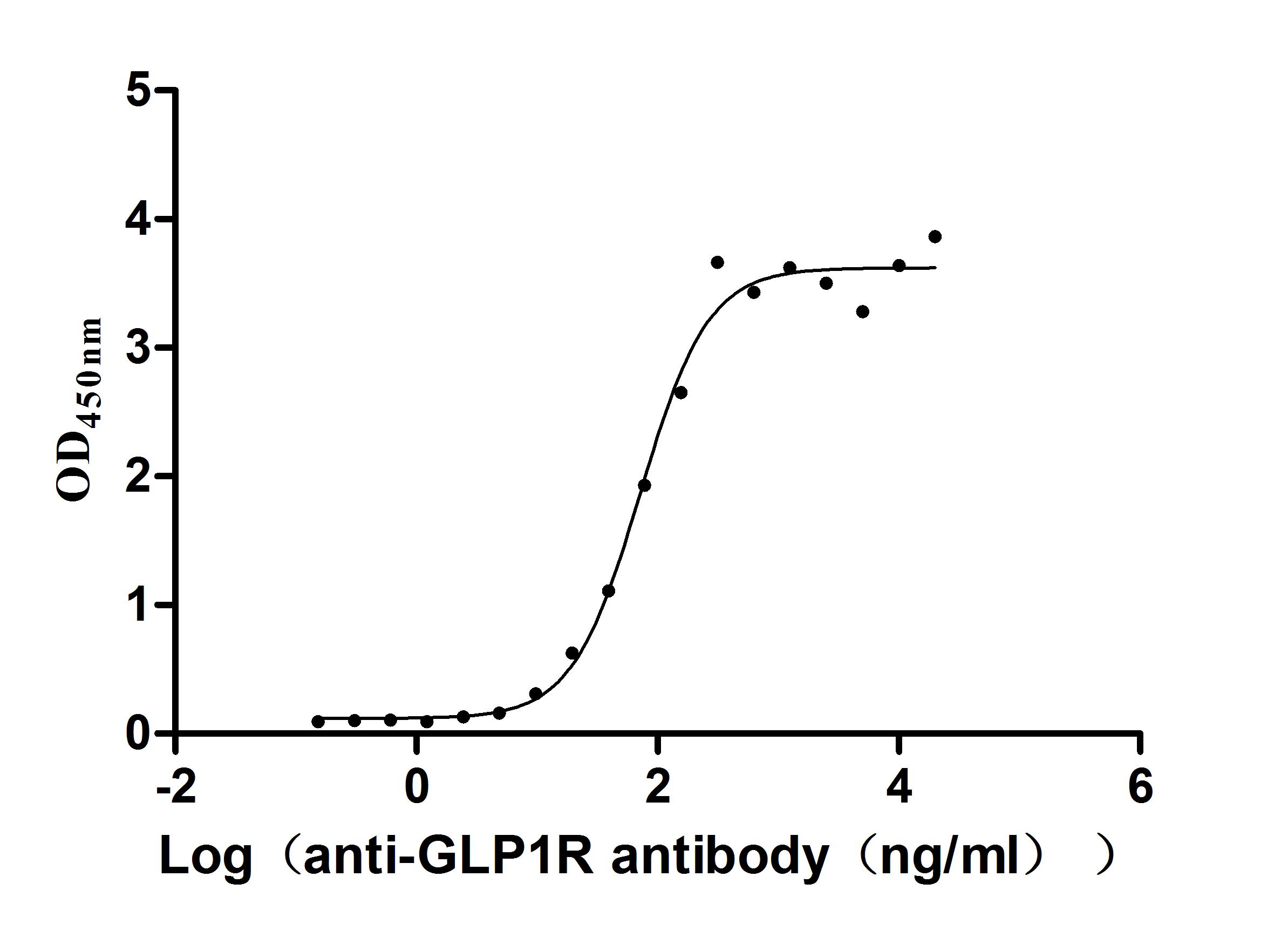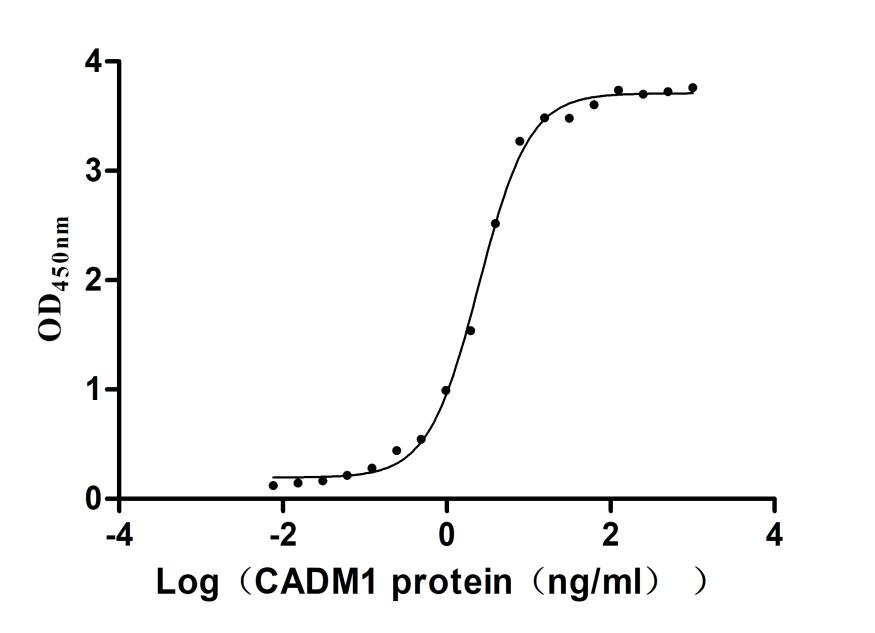Recombinant Dog Mast/stem cell growth factor receptor Kit (KIT), partial
-
中文名稱:熟悉的犬KIT重組蛋白
-
貨號:CSB-YP012375DO
-
規格:
-
來源:Yeast
-
其他:
-
中文名稱:熟悉的犬KIT重組蛋白
-
貨號:CSB-EP012375DO
-
規格:
-
來源:E.coli
-
其他:
-
中文名稱:熟悉的犬KIT重組蛋白
-
貨號:CSB-EP012375DO-B
-
規格:
-
來源:E.coli
-
共軛:Avi-tag Biotinylated
E. coli biotin ligase (BirA) is highly specific in covalently attaching biotin to the 15 amino acid AviTag peptide. This recombinant protein was biotinylated in vivo by AviTag-BirA technology, which method is BriA catalyzes amide linkage between the biotin and the specific lysine of the AviTag.
-
其他:
-
中文名稱:熟悉的犬KIT重組蛋白
-
貨號:CSB-BP012375DO
-
規格:
-
來源:Baculovirus
-
其他:
-
中文名稱:熟悉的犬KIT重組蛋白
-
貨號:CSB-MP012375DO
-
規格:
-
來源:Mammalian cell
-
其他:
產品詳情
-
純度:>85% (SDS-PAGE)
-
基因名:
-
Uniprot No.:
-
別名:KITMast/stem cell growth factor receptor Kit; SCFR; EC 2.7.10.1; Proto-oncogene c-Kit; Tyrosine-protein kinase Kit; CD antigen CD117
-
種屬:Canis familiaris (Dog) (Canis lupus familiaris)
-
蛋白長度:Partial
-
蛋白標簽:Tag?type?will?be?determined?during?the?manufacturing?process.
The tag type will be determined during production process. If you have specified tag type, please tell us and we will develop the specified tag preferentially. -
產品提供形式:Lyophilized powder
Note: We will preferentially ship the format that we have in stock, however, if you have any special requirement for the format, please remark your requirement when placing the order, we will prepare according to your demand. -
復溶:We recommend that this vial be briefly centrifuged prior to opening to bring the contents to the bottom. Please reconstitute protein in deionized sterile water to a concentration of 0.1-1.0 mg/mL.We recommend to add 5-50% of glycerol (final concentration) and aliquot for long-term storage at -20℃/-80℃. Our default final concentration of glycerol is 50%. Customers could use it as reference.
-
儲存條件:Store at -20°C/-80°C upon receipt, aliquoting is necessary for mutiple use. Avoid repeated freeze-thaw cycles.
-
保質期:The shelf life is related to many factors, storage state, buffer ingredients, storage temperature and the stability of the protein itself.
Generally, the shelf life of liquid form is 6 months at -20°C/-80°C. The shelf life of lyophilized form is 12 months at -20°C/-80°C. -
貨期:Delivery time may differ from different purchasing way or location, please kindly consult your local distributors for specific delivery time.Note: All of our proteins are default shipped with normal blue ice packs, if you request to ship with dry ice, please communicate with us in advance and extra fees will be charged.
-
注意事項:Repeated freezing and thawing is not recommended. Store working aliquots at 4°C for up to one week.
-
Datasheet :Please contact us to get it.
靶點詳情
-
功能:Tyrosine-protein kinase that acts as cell-surface receptor for the cytokine KITLG/SCF and plays an essential role in the regulation of cell survival and proliferation, hematopoiesis, stem cell maintenance, gametogenesis, mast cell development, migration and function, and in melanogenesis. In response to KITLG/SCF binding, KIT can activate several signaling pathways. Phosphorylates PIK3R1, PLCG1, SH2B2/APS and CBL. Activates the AKT1 signaling pathway by phosphorylation of PIK3R1, the regulatory subunit of phosphatidylinositol 3-kinase. Activated KIT also transmits signals via GRB2 and activation of RAS, RAF1 and the MAP kinases MAPK1/ERK2 and/or MAPK3/ERK1. Promotes activation of STAT family members STAT1, STAT3, STAT5A and STAT5B. Activation of PLCG1 leads to the production of the cellular signaling molecules diacylglycerol and inositol 1,4,5-trisphosphate. KIT signaling is modulated by protein phosphatases, and by rapid internalization and degradation of the receptor. Activated KIT promotes phosphorylation of the protein phosphatases PTPN6/SHP-1 and PTPRU, and of the transcription factors STAT1, STAT3, STAT5A and STAT5B. Promotes phosphorylation of PIK3R1, CBL, CRK (isoform Crk-II), LYN, MAPK1/ERK2 and/or MAPK3/ERK1, PLCG1, SRC and SHC1.
-
基因功能參考文獻:
- the pan deubiquitinating enzyme inhibitor PR619 prevented imatinib induction of KIT overexpression, suggesting that the imatinib-induced decrease in KIT ubiquitination could be mediated by upregulation and/or activation of deubiquitinating enzyme(s). It may be possible that a similar mechanism of KIT overexpression underlies the acquisition of imatinib resistance in some human tumors that are driven by KIT mutation. PMID: 28765927
- Tumors with KIT mutations showed genome-wide aberrant copy number profiles, with frequent CNAs (DNA copy number aberrations) involving genes in the p53 and RB pathways, whereas CNAs were very limited in tumors with wild-type KIT PMID: 28058543
- KTN0158 inhibits KIT phosphorylation, demonstrates an acceptable safety profile in dogs, and provides objective responses in canine MCT patients with and without activating KIT mutations, supporting future clinical evaluation of KTN0158 in people. PMID: 27815356
- the high incidence of GNSK-deletion c-kit in canine HSAs implicates KIT isoforms as possibly participating in the tumorigenesis of canine hemangiosarcomas. PMID: 27422008
- data indicate that c-KIT exon 11 mutations occur frequently in canine gastrointestinal stromal tumours PMID: 26631948
- These findings indicate that canine gastrointestinal stromal, and possibly mast cell tumors,may be responsive to molecular-targeted therapy. PMID: 26074249
- Ki67(-)/KIT(+) animals had a longer survival time than Ki67(+)/KIT(+) animals (p=0.03). PMID: 26412531
- This is the first report demonstrating the tumorigenic potential of a mutation in the extracellular domain of KIT. PMID: 25965812
- The relationship between KIT gene expression and tumor recurrence and mortality in dogs with cutaneous mast cell tumors was investigated via RT-PCR and immunohistochemistry. PMID: 23294979
- Substantial genetic heterogeneity across SLC6A3 demonstrated within a single breed suggests that effects of SLC6A3 on behavior may be complex and wide ranging. PMID: 23659249
- This study analyzed c-kit mRNA and protein expression and mutations in B-cell and T-cell canine lymphomas using an integrated analytic approach. PMID: 23791075
- These findings suggest that a subset of canine malignant melanomas harbors a KIT exon 11 mutation. PMID: 23069279
- These findings demonstrate that the Kiupel grading system is a useful prognostic tool for canine cutaneous mast cell tumors in predicting overall and progression free survival (PFS); occurrence of ITD-Exon11 appeared to be a useful predictor of PFS. PMID: 23384436
- Tandem duplication of KIT exon 11 influences the proteome of canine mast cell tumours PMID: 22935087
- Mutations on c-KIT exons 8-11 and 17 were investigated by cDNA sequencing. Higher amounts of c-KIT mRNA were found in acute leukemia compared to chronic lymphocytic leukemia, and the latter showed a lower pattern of gene expression. PMID: 23375718
- In the gliomas reported in this study, none expressed COX2; none were immunoreactive for c-kit, although all three high-grade tumours had intramural vascular expression. PMID: 22235799
- Transcriptome analysis of the mast cell line C2 treated for up to 72 h with masitinib identified significant changes in the expression levels of approximately 3500 genes or 16% of the canine genome. PMID: 22747577
- In canine cutaneous melanocytic tumors c-kit-labeling extension pattern was similar to that usually observed in human tumors. PMID: 22407004
- The inhibitory effect of four tyrosine kinase inhibitors on proliferation and phosphorylation of c-Kit receptor as well as the expression and function of ABCB1 were investigated in tumor cell lines. PMID: 21480930
- Histopathological and immunohistological analysis of PLAP, KIT, DAZ and DMRT1 expression revealed that canine seminomas closely resemble human spermatocytic seminomas. PMID: 21615421
- 20 of 39 cases of malignant oral melanomas were positive for KIT protein, with no significant difference between KIT expression and overall survival. PCR amplification and sequencing of KIT exon 11 in 17 samples did not detect any mutations. PMID: 21848624
- The utility of c-KIT mutations as prognostic markers for mast cell tumors is reported. PMID: 21160022
- Canine and human gastrointestinal stromal tumors display similar mutations in c-KIT exon 11 PMID: 20950418
- In human MC, the KIT D816V mutant introduces resistance, and in canine mastocytomas, an exon 11 polymorphism may be indicative of resistance against INNO-406. PMID: 20685234
- No c-kit mutations or polymorphisms were identified in exons 16-20 (the phosphotransferase portion of c-KIT's kinase domain) of any mast cell tumors. Such mutations do not play a big role in progression or the aberrant location of KIT in canine MCTs. PMID: 16579858
- Canine mast cell tumors are an excellent model for characterizing the role of c-KIT in neoplastic diseases and is a potential target for novel therapeutic agents in clinical trials. PMID: 16611403
- The results of a study evaluating role for c-KIT in the progression of canine mast cell tumors is reported. PMID: 17491070
- Report that more aggressive biologic behavior of canine mast cell tumors is associated with increased c-kit expression, suggesting a role for c-kit, as a useful marker, in diagnostic pathology and in tumor progression. PMID: 18608529
- This study shows that activating mutations in not only exon 11 but also exons 8 and 9 are common in canine mast cell tumors. PMID: 18644978
- RAS, FLT3, and C-KIT mutations, analogous to those found in human leukemia, occur commonly in acute canine leukemia. PMID: 18977066
顯示更多
收起更多
-
亞細胞定位:Cell membrane; Single-pass type I membrane protein.
-
蛋白家族:Protein kinase superfamily, Tyr protein kinase family, CSF-1/PDGF receptor subfamily
-
數據庫鏈接:
Most popular with customers
-
Recombinant Human Tumor necrosis factor receptor superfamily member 11B (TNFRSF11B) (Active)
Express system: Mammalian cell
Species: Homo sapiens (Human)
-
Recombinant Human IGF-like family receptor 1 (IGFLR1), partial (Active)
Express system: Mammalian cell
Species: Homo sapiens (Human)
-
Recombinant Macaca mulatta Microtubule-associated protein tau (MAPT) (Active)
Express system: Mammalian cell
Species: Macaca mulatta (Rhesus macaque)
-
Recombinant Macaca mulatta Semaphorin-4D isoform 1 (SEMA4D), partial (Active)
Express system: Mammalian cell
Species: Macaca mulatta (Rhesus macaque)
-
Recombinant Dog Angiopoietin-2 (ANGPT2) (Active)
Express system: Mammalian cell
Species: Canis lupus familiaris (Dog) (Canis familiaris)
-
Recombinant Human Glucagon-like peptide 1 receptor (GLP1R), partial (Active)
Express system: Mammalian cell
Species: Homo sapiens (Human)
-
Recombinant Human Cytotoxic and regulatory T-cell molecule (CRTAM), partial (Active)
Express system: Mammalian cell
Species: Homo sapiens (Human)
-
Recombinant Human Dipeptidase 3(DPEP3), partial (Active)
Express system: Mammalian cell
Species: Homo sapiens (Human)


